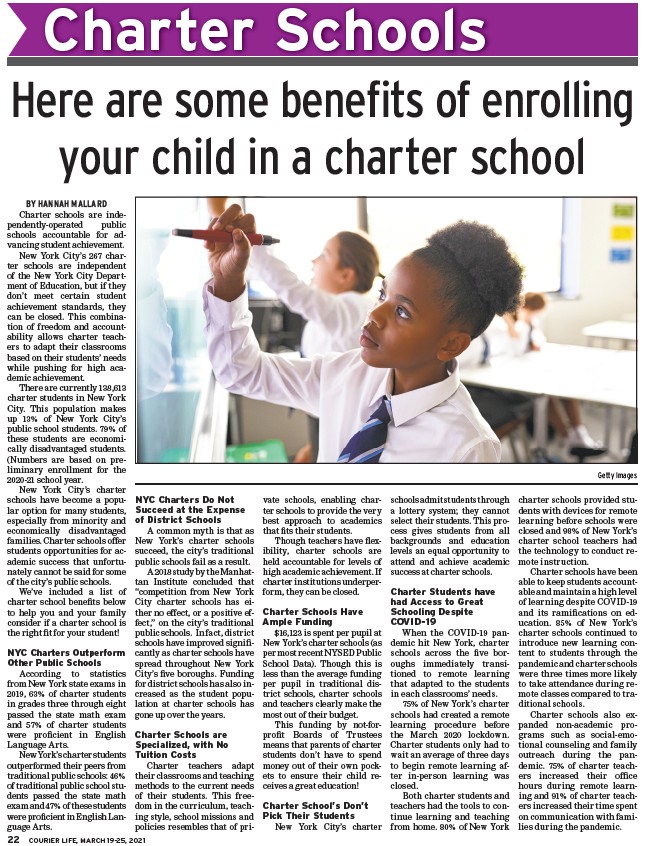
Charter Schools
Here are some benefi ts of enrolling
your child in a charter school
BY HANNAH MALLARD
Charter schools are independently
operated public
schools accountable for advancing
student achievement.
New York City’s 267 charter
schools are independent
of the New York City Department
of Education, but if they
don’t meet certain student
achievement standards, they
can be closed. This combination
of freedom and accountability
allows charter teachers
to adapt their classrooms
based on their students’ needs
while pushing for high academic
achievement.
There are currently 138,613
charter students in New York
City. This population makes
up 13% of New York City’s
public school students. 79% of
these students are economically
disadvantaged students.
(Numbers are based on preliminary
enrollment for the
2020-21 school year.
New York City’s charter
schools have become a popular
option for many students,
especially from minority and
economically disadvantaged
families. Charter schools offer
students opportunities for academic
success that unfortunately
cannot be said for some
of the city’s public schools.
We’ve included a list of
charter school benefi ts below
to help you and your family
consider if a charter school is
the right fi t for your student!
NYC Charters Outperform
Other Public Schools
According to statistics
from New York state exams in
2019, 63% of charter students
in grades three through eight
passed the state math exam
and 57% of charter students
were profi cient in English
Language Arts.
New York’s charter students
outperformed their peers from
traditional public schools: 46%
of traditional public school students
passed the state math
exam and 47% of these students
were profi cient in English Language
Arts.
NYC Charters Do Not
Succeed at the Expense
of District Schools
COURIER L 22 IFE, MARCH 19-25, 2021
A common myth is that as
New York’s charter schools
succeed, the city’s traditional
public schools fail as a result.
A 2018 study by the Manhattan
Institute concluded that
“competition from New York
City charter schools has either
no effect, or a positive effect,”
on the city’s traditional
public schools. In fact, district
schools have improved signifi -
cantly as charter schools have
spread throughout New York
City’s fi ve boroughs. Funding
for district schools has also increased
as the student population
at charter schools has
gone up over the years.
Charter Schools are
Specialized, with No
Tuition Costs
Charter teachers adapt
their classrooms and teaching
methods to the current needs
of their students. This freedom
in the curriculum, teaching
style, school missions and
policies resembles that of private
schools, enabling charter
schools to provide the very
best approach to academics
that fi ts their students.
Though teachers have fl exibility,
charter schools are
held accountable for levels of
high academic achievement. If
charter institutions underperform,
they can be closed.
Charter Schools Have
Ample Funding
$16,123 is spent per pupil at
New York’s charter schools (as
per most recent NYSED Public
School Data). Though this is
less than the average funding
per pupil in traditional district
schools, charter schools
and teachers clearly make the
most out of their budget.
This funding by not-forprofi
t Boards of Trustees
means that parents of charter
students don’t have to spend
money out of their own pockets
to ensure their child receives
a great education!
Charter School’s Don’t
Pick Their Students
New York City’s charter
schools admit students through
a lottery system; they cannot
select their students. This process
gives students from all
backgrounds and education
levels an equal opportunity to
attend and achieve academic
success at charter schools.
Charter Students have
had Access to Great
Schooling Despite
COVID-19
When the COVID-19 pandemic
hit New York, charter
schools across the fi ve boroughs
immediately transitioned
to remote learning
that adapted to the students
in each classrooms’ needs.
75% of New York’s charter
schools had created a remote
learning procedure before
the March 2020 lockdown.
Charter students only had to
wait an average of three days
to begin remote learning after
in-person learning was
closed.
Both charter students and
teachers had the tools to continue
learning and teaching
from home. 80% of New York
Getty Images
charter schools provided students
with devices for remote
learning before schools were
closed and 98% of New York’s
charter school teachers had
the technology to conduct remote
instruction.
Charter schools have been
able to keep students accountable
and maintain a high level
of learning despite COVID-19
and its ramifi cations on education.
85% of New York’s
charter schools continued to
introduce new learning content
to students through the
pandemic and charter schools
were three times more likely
to take attendance during remote
classes compared to traditional
schools.
Charter schools also expanded
non-academic programs
such as social-emotional
counseling and family
outreach during the pandemic.
75% of charter teachers
increased their offi ce
hours during remote learning
and 91% of charter teachers
increased their time spent
on communication with families
during the pandemic.